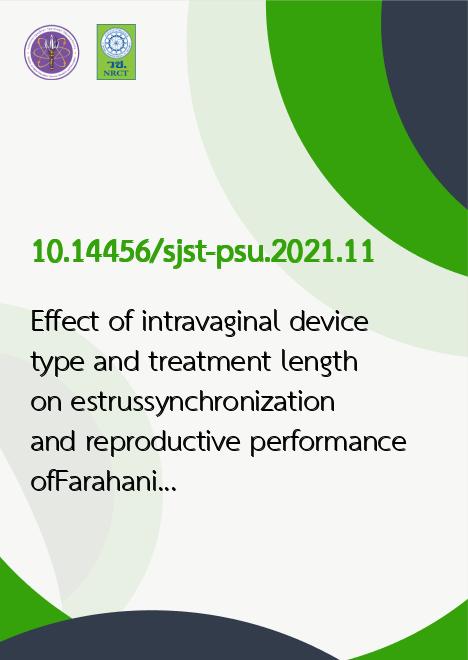
|
Effect of intravaginal device type and treatment length on estrussynchronization and reproductive performance ofFarahani ewes out of breeding season |
|---|---|
| รหัสดีโอไอ | |
| Creator | 1. Aliasghar Moghaddam 2. Hamid Kohram 3. Peyman Rahimi-Feyli 4. Ghadir Sohrabi |
| Title | Effect of intravaginal device type and treatment length on estrussynchronization and reproductive performance ofFarahani ewes out of breeding season |
| Publisher | Research and Development Office, Prince of Songkla University |
| Publication Year | 2564 |
| Journal Title | Songklanakarin Journal of Science and Technology (SJST) |
| Journal Vol. | 43 |
| Journal No. | 1 |
| Page no. | 80-86 |
| Keyword | FGA sponges, CIDR, out of season, Farahani ewe, estrus synchronization |
| URL Website | https://rdo.psu.ac.th/sjstweb/index.php |
| ISSN | 0125-3395 |
| Abstract | This study was conducted to evaluate reproductive performance of Farahani ewes subjected to four estrus synchronization programs. Twenty four ewes were synchronized with flurogestone acetate sponges (FGA) or controlled internal drugrelease (CIDR) devices for 6 (S6 and C6 groups) or 12 (S12 and C12 groups) days and an equine chorionic gonadotropin (eCG)on device removal. The mean prolificacy and twinning rates were higher in C6, C12 and S12 than in S6 group. Meanprogesterone (P4) concentration at device withdrawal was higher in C6 and S6 than in C12 and S12 groups. Mean P4concentration at estrus was higher in S12 than in S6 group. Mean P4 concentrations thirty days after device withdrawal werehigher in C12 and S12 than in C6 and S6 groups. In conclusion, a short-term CIDR treatment has an efficacy comparable to thatof a long-term FGA or CIDR treatment during the physiological anestrum of ewes. |
